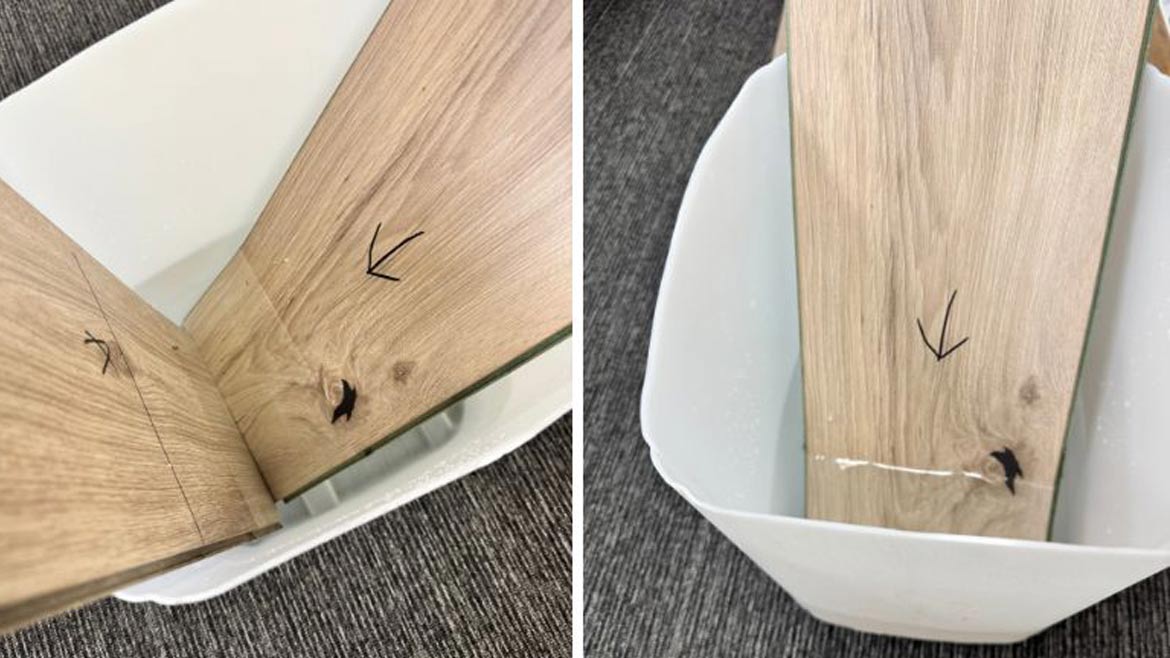Op-Ed
The Waterproof Laminate Myth: Why Consumer Expectations May Never Be Met

Paul Hambidge, founder and managing director of Factory Direct Flooring in the U.K.
Photo: Factory Direct Flooring.
Laminate flooring has established itself as a staple in American homes. It is prized for its affordability and versatile designs that mimic high-end materials. In recent years, the demand for "waterproof laminate" has surged across the U.S., with online searches growing by 13% in the past month and 5% in the past quarter, according to Google Trends data.
While European laminate flooring producers have declared it a top flooring trend for 2025, UK industry expert Paul Hambidge offers a contrarian view. With over two decades of industry experience, the founder and managing director of Factory Direct Flooring believes manufacturers will never truly deliver a waterproof laminate product that meets American consumers' expectations despite the marketing claims flooding the market.
In this op-ed, Hambidge explains the gaps between industry claims and consumer understanding.
I’ve spent years looking for a laminate product that can genuinely be called “waterproof.” Consumers ask for this all the time, and I understand why. They want peace of mind that their flooring can handle unexpected spills, leaks, or even—given the storms the UK has faced in recent months—the occasional flood.
To try and meet this demand, I have rigorously tested numerous prototypes from manufacturers worldwide, simulating real-life scenarios that might occur in a household. One such test involved submerging a laminate plank under water for a week. At first, the results seemed promising, with no visible damage. But the truth came when the plank began to dry out after—and in some cases, this can take as long as three months.
That’s when the problems start. As the plank slowly dries out, the fine layers that make up the laminate begin to swell. Even if the swelling isn’t immediately obvious, it compromises the integrity of the board over time.

Waterproof laminate prototype testing at Factory Direct headquarters. Photo: Factory Direct Flooring.
Understanding the construction of laminate flooring is key to understanding its limitations. Laminate is made up of multiple layers: a durable wear layer on top, a printed design layer, and a core layer of high-density fiberboard (HDF). While the top layer may resist water, the core is highly susceptible to moisture—but just how susceptible it is can vary because the HDF used by one manufacturer can have different densities (and, therefore, different levels of water resistance) from that of another.
Manufacturers have developed production processes to enhance laminate’s water resistance, utilizing techniques like wrapping or beveling the edges—sometimes both. Before beveling, laminate planks had square edges. Beveling was introduced for aesthetic reasons, as it creates a more distinctive plank and better mimics the appearance of real wood floors. Additionally, manufacturers found that beveling helps mask any swelling resulting from water exposure, which would otherwise be more apparent on square-edged laminate.
However, to keep production costs down, some manufacturers simply paint the beveled edge on them rather than wrap them. This might look the part, but it doesn’t offer any disguise for swelling. Laminate flooring planks with both beveled and wrapped edges perform much better (and this is where a lot of our preferred manufacturers are now focusing their water-resistance efforts) because they temporarily prevent water from penetrating the inner fiberboard. But ultimately, for the consumer, they’re not a perfect solution either because, in time, water will find its way through the joints—though manufacturers are also making improvements here.
One of the biggest issues is the disconnect between the industry’s definition of “waterproof” and consumers' expectations.
In the flooring industry, one common way to test laminate’s water resistance is to click the floorboards together, pour water over the joints, and measure how much (if any) water penetrates within 24 hours. If no water penetrates in that timeframe, the product may be marketed as waterproof.
That’s all well and good for spills or accidents that are cleaned up quickly, but what happens in a real-life scenario, like a burst pipe in the back of a cupboard that goes unnoticed for a few days? In my laminate tests, water always finds its way through. Consumers deserve to know that the industry standard test isn’t a guarantee of flood-proof flooring.
There’s also no telling exactly how much water one manufacturer uses compared to another.
Each manufacturer conducts its own tests. There’s no universal standard, so the level of water resistance can vary widely from one brand to another, meaning that consumers often don’t know what they’re getting until it’s too late.
The lack of regulation and universal standards is a major issue. While one manufacturer may leave water on flooring joints for 24 hours, another may use less water in their tests, rendering the measure of water resistance unreliable for the consumer. This is unlike other retail industries, such as clothing, where standardized waterproof classifications must be met before a product can be marketed. I believe the flooring industry should adopt more rigorous and standardized testing methods that mimic real-life conditions more closely.
A universal test could involve fully submerging the boards for several days and measuring their swell factors (a unit that determines how much the board will swell from water exposure compared to its current size). To more effectively mimic real-life scenarios, I recommend testing how long it takes for water to penetrate the core board through the top and bottom layers. Until then, I advise consumers to approach waterproof claims of laminate flooring products with caution.
NALFA’s Surface Swell - Assembled Joint test method attempts to establish a standardized approach to assessing laminate’s water resistance capabilities, and any NALFA-approved certification for laminate flooring in the U.S. needs to first be tested by an independent third party. This is a more stringent regulatory system compared to what I’ve seen in other markets, though classing ‘waterproof’ and ‘water resistant’ as interchangeable is a misstep. These are two different things.
Despite the challenges, laminate flooring remains an excellent choice for many homes. It has many benefits: it’s affordable, easy to install, and comes in many styles. However, it won’t perform like luxury vinyl tile (LVT) or stone plastic composite (SPC) regarding water resistance.
In my nearly 35 years working in the flooring industry, I've seen incredible strides in water resistance. Some German manufacturers—including Unilin, Kronotex, and Classen—are actively improving the composition of their core boards, developing stronger water resistance and a reduced swell factor, and ultimately improving laminate flooring’s value for money for the consumer. However, overall, we’re yet to bridge the gap between manufacturers’ claims and consumer expectations when delivering a truly waterproof product.
The best water-resistant flooring types on the market are SPC (stone plastic composite) and LVT (luxury vinyl tile). SPC's core is compact and sturdy and normally made of limestone or plasticizers, making it a stronger, more durable, and impact-resistant product. Although both SPC and LVT are water resistant, SPC offers the highest protection against water damage when paired with waterproof sealant around the room’s edges. This makes it popular in wet rooms, bathrooms, and flood-prone homes.
Looking for a reprint of this article?
From high-res PDFs to custom plaques, order your copy today!





